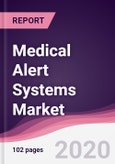What is Medical Alert Systems Market?
Medical Alert System is a device which is used to signal the medical personnel during emergency. These devices encompass a wide range of medical devices such as Personal Emergency Response Systems (PERS), Nurse Call Systems (NCS), Ambulatory Auto Alert Systems, Automated Airborne Flight Alert Systems and others. This device increases the safety and security of the patients. It was primarily developed for senior citizens or the patients suffering from long-term disabilities. This device has additional safety features such as fire and smoke alert, carbon monoxide monitoring and others that help medical staff to understand the surrounding in order to face any situation.
According to the World Health Organization report, nearly 37.3 million are found falling owing to the health risk every year and these people require medical attention. Also, around 646,000 people die from falls across the globe each year. This trend is anticipated to continue and hence the need for medical alert systems is anticipated to grow further in near future.
There is a rise in integration of healthcare communication technologies including patient monitoring devices to personal communication devices such as smartphones and tablets. With technological advancements, the nursing staff and hospital administration have access to nurse call systems from remote mobile devices as well as office computers to get real time monitoring data from patients.
This report incorporates an in-depth assessment of medical alert systems market by type, end users and geography.
What are the major end users for Medical Alert Systems?
The various end users assessed include hospitals and clinics, home-based users, senior living facilities, assisted living facilities and others. Hospitals and assisted living facilities are the dominant end user segments which combinedly accounted for nearly 60% of the global medical alert systems market revenue. The growing hospital industry is will witness a proportionate rise in implementation of NCS across healthcare facilities. Furthermore, increase in number of emergency care facilities, clinics as well as specialty hospitals are anticipated to enhance the medical alert systems market. Rising healthcare costs is anticipated to increase the adoption of medical alert systems across various end users including hospitals and clinics, home-based users, senior living facilities, assisted living facilities and others.
Medical Alert Systems Market
Market Research and Market Trends of Medical Alert Systems Market
TruSense has combined wireless sensors, Amazon’s Echo Dot, and GPS technology to track patients daily activities and health statistics, and send that data to family members and healthcare professionals. These smart sensors keep a track of the health statistics and indicate the shift in health statistics and send alerts to the healthcare professionals unlike conventional emergency response systems and hence brought revolution in the healthcare industry
Technological advancement in fall detection devices and high frequent launch of these devices by manufacturers such as ActiveProtectiv, Kardian and others is anticipated to affect the growth of the medical alert systems market in near future
In 2018, Samsung Electronics America and MobileHelp have entered into collaboration for integration of personal emergency response capabilities to Samsung Gear S3 smartwatches. Increasing number of collaborations by key players of medical alert devices is anticipated to provide prospects to the medical alert systems market in near future
In 2018, companies such as ZTE, Qualcomm, and Wearsafe have partnered to integrate personal security tracking system to wearable devices. This partnership is anticipated to provide ample amount of opportunities in near future.
Who are the Major Players in Medical Alert Systems market?
The companies referred to in the market research report include Koninklijke Philips N.V., Rauland-Borg Corporation, Honeywell International, Ascom Wireless Solutions, ADT Corporation (US), Tunstall Healthcare Group Ltd., Valued Relationships, Inc., Medical Guardian LLC, Hill-Rom Holdings Inc., Jeron Electronic Systems Inc. and more than 20 companies.
What is our report scope?
The report incorporates in-depth assessment of the competitive landscape, product market sizing, product benchmarking, market trends, product developments, financial analysis, strategic analysis and so on to gauge the impact forces and potential opportunities of the market. Apart from this the report also includes a study of major developments in the market such as product launches, agreements, acquisitions, collaborations, mergers and so on to comprehend the prevailing market dynamics at present and its impact during the forecast period 2018-2023.
Key Takeaways from this Report
- Evaluate market potential through analyzing growth rates (CAGR %), Volume (Units) and Value ($M) data given at country level – for product types, end use applications and by different industry verticals.
- Understand the different dynamics influencing the market – key driving factors, challenges and hidden opportunities.
- Get in-depth insights on your competitor performance – market shares, strategies, financial benchmarking, product benchmarking, SWOT and more.
- Analyze the sales and distribution channels across key geographies to improve top-line revenues.
- Understand the industry supply chain with a deep-dive on the value augmentation at each step, in order to optimize value and bring efficiencies in your processes.
- Get a quick outlook on the market entropy – M&A’s, deals, partnerships, product launches of all key players for the past 4 years.
- Evaluate the supply-demand gaps, import-export statistics and regulatory landscape for more than top 20 countries globally for the market.
Table of Contents
Methodology

LOADING...








